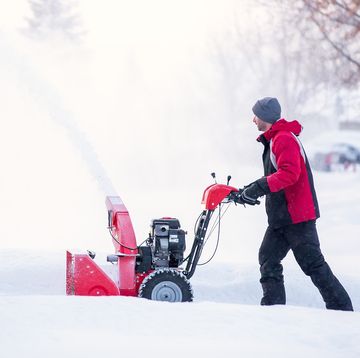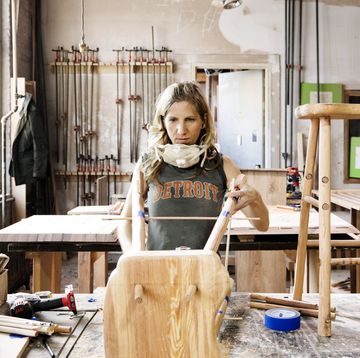DIY Backyard Beekeeping: A Guide for Beginners
If you can garden, you can be a beekeeper. Here are the first steps: the questions to ask, the equipment you'll need and how to choose the right bees.

If you can garden, you can be a beekeeper. Here are the first steps: the questions to ask, the equipment you'll need and how to choose the right bees.
Why Be a Backyard Beekeeper?

If you can garden, you can be a beekeeper. It takes about the same amount of time and effort to keep your veggies producing as it does to keep bees. One big bonus of beekeeping: They help your vegetables, flower and other garden plants thrive! Oh, and then -- of course -- there's the honey (not to mention the joy of a new hobby, and the knowledge that you're doing something to help bees at a time when this critical pollinator is in crisis).
The Daily Green asked our own Kim Flottum, The Beekeeper blogger, to outline the first steps you'd need to take to get started. Happy beekeeping!
- Dan Shapley
First Questions

There are several things you should consider before you become a beekeeper, but they are no different than if you were to going to begin caring for any other animal ... dogs, cats, chickens or llamas.
First, where will you keep them? Many beginners don't even think beyond their backyards, and that's a good place to start, but don't take bees, backyards, zoning, neighbors and your family for granted. Check them all out first.
Check Your Yard, the Law ... and Your Family

Is your backyard big enough for a beehive or two? A typical sized city lot of about a tenth of an acre or so, even one as large as large as a half acre can accommodate one or maybe two colonies when there are other space considerations -- like a family that uses the backyard for recreational play, cookouts, family pets or a flower or vegetable garden.
Do your zoning regulations permit bees where you live? Check before you go further because you may be violating some local ordinance or other and the zoning police frown on citizens breaking these taboos.
And of course your family needs to sign off on this enterprise. Your spouse, kids, pets … all need to know that bees will be around. Is anyone allergic the sting of a honey bee? A tiny percent of the population is you know (just like peanuts, shellfish or horseradish) … maybe you are and don't know it. If you don't know … say, from a previous experience, get tested by a family doctor. Emergency room trips are scary, and expensive.
And Don't Forget Your Neighbors

What about neighbors? You need to go through the same procedures. This is especially true if you haven't had the chance to provide a screen or other sight-barrier yet, or if your hives are just plain out in the open. Even though having bees may be legal where you are, enduring the undying dislike or distrust of your next door neighbor usually isn't worth the trouble. Find a different place.
If it's OK with the city fathers, your family and the neighbors, consider a few more precautions. Out of sight, out of mind is a good idea. Colonies don't need to be white ... they can be brown, green, natural or mottled in color. The prying eyes of mischievous children can be averted if they can't see your bees. A screen of hedge plants (annuals like sunflowers, or evergreens like arborvitae are good ideas), or behind a building like your garage so folks just don't see them. This also makes your bees fly up and away when leaving their hive, and return from up above your screen so that they aren't flying at human height, and those types of close encounters can be interesting.
Get a Hive Stand

Plan to keep your hives up off the ground. This is a typical, easily constructed and inexpensive hive stand. It is made of treated 2x4s and cement blocks. Note that the hives are about 18 inches or so off the ground to protect them from skunks, and there is room between each hive to place the covers and honey supers when examining the hives later in the season. Setting hive components all the way down on the ground is hard on the back ... and lifting them again is a lot harder. Consider, too, something on the ground around your hives to keep the mud down ... like bark mulch, old carpeting, or gravel or stones.
Learn How Bees Naturally Form a Hive

When left to their own devices, honey bees will nest in cavities of about 2–3 cubic feet, and hollows in trees and the spaces between joists in houses seem to be about the right size. This diagram, from my book on beginning beekeeping (The Backyard Beekeeper) demonstrates a typical nest in a tree. Natural nests are generally constructed so that the place to store honey is near the top and wraps around the outsides of the nest (gold area), surrounding the nest as a protective layer; pollen, the main brood food is stored below the honey (the white areas) very near the brood area and the brood nest, where the queen lays eggs and the young are raised, is in the lower, most protected section of the nest (brown areas).
Build Your Hives to Suit Their Needs

You have to imagine a honey bee colony as a sphere in this space rather than a collection of combs hanging from the top. Your bees in your beehive will construct their nest in very much the same way. Honey on top, pollen surrounding the brood nest and brood near the bottom. Keep that arrangement in mind.
Protect Yourself

One of the first things you have to get is protective gear. You need a veil of some sort to keep errant bees from becoming entangled in your hair. A simple hat and veil combo is what many beekeepers use, especially when it is hot, and they won't be doing much dirty work.
A lightweight jacket with attached veil is a good choice when doing regular beework, and you want to keep clean, but don't need a full suit. The veil unzips and you can throw it back if you need a drink or are driving to another beeyard.
Get the Full Suit

A full bee suit and gloves are needed when doing heavy-duty beework, when the weather isn't just right and the bees are not in a great mood, or when you have to move fast to get done before dark. Many beginning beekeepers start out with gear like this because they are unaccustomed to working with bees. The first few times you have bees walking on your hands or on your fingers may be a bit distracting. If you find it uncomfortable then gloves are advised. In fact, we encourage you to wear all the protective gear you feel necessary because if you are uncomfortable with out a full suit, or gloves or whatever, you will not enjoy working bees, and you will soon find excuses not to go to the hive ... and your days as a beekeeper are numbered.
Get a Smoker

A beekeeper's best friend is his or her smoker. A smoker is simply a cylinder with a bellows attached. In the cylinder you build a slow burning fire, using pine needles, old burlap, rotten wood or even commercially prepared smoker fuel. A slow burning fire produces mostly smoke, and when the bellow are squeezed, smoke comes out of the nozzle. When smoke enters the beehive when you are working in the hive, a couple of things happen. First, a honey bee's natural instinct when confronted with smoke is to react as if there is a forest fire, and the natural home (recall that hollow tree?) is about to be consumed. Escape is the first defense, and worker bees will duck into the hive and eat as much honey as they can to take with them when they abandon the hive and seek out a new nest. Thus, they are busy when you are working, and they pretty much leave you alone. Second, communication in a beehive is chemical ... pheromones waft around the hive continuously, produced by the queen, other workers, the brood and even drones. These chemical messages tell other bees what to do, when to do it and when to stop. Smoke interferes with these messages, and communication breaks down ... and when that happens you can go into a hive and do your work, being left pretty much alone because nobody can talk, and nobody can hear ... chemically. Keep your smoker lit at all times.
Choosing a Home for Your Bees

Now that we've discussed the safety gear you'll need, and the place to put your bees, and the tools you'll need to work with your bees, it's time to look at the actual boxes you can use to keep your bees in. Recall that bees live on vertical-hanging beeswax sheets that hang inside the boxes you will get. These sheets are suspended at the top by a bar of wood that just fits into a groove at the top of the box, with the other three sides of the beeswax sheet enclosed in a 'frame' of wood to keep it secure so it doesn't bend. This photo shows the frame with the beeswax sheet, full of honey.
Make Way for 'Bee Space'

Beeswax is relatively solid, but will bend if forced, which is why beekeepers use these wooden, and sometimes plastic 'frames.' Each of these sheets surrounded by a wooden frame is called, not surprisingly, a "Frame." It looks like this inside when viewing a cross section. Note the small space that exists all the way around the outside of the frame. This is how bees get around inside their home, walking around their 'bee space.'
Bee Frame Recommendations

Beekeepers use different sized boxes (with corresponding different sized 'frames' inside, as seen here). There are boxes that hold 10 frames and are 9.5-inches tall, called deeps; some are 6.5-inches tall, and are called mediums, and some are 5-7/8-inches tall and are called shallows. A deep box with 10 frames, when full of frames of beewax, honey and bees weighs about 90 pounds, a medium about 40 pounds and a shallow about 30 pounds.
Some beekeepers, me included, use boxes that are the same heights, but hold only 8 frames each, and weigh correspondingly less. Choosing your boxes depends to a great degree on how much you wish to lift when working your bees. My advice is to use all 8-frame, medium-sized boxes because they are light enough to work easily and the bees don't mind. I use 3 medium boxes on the bottom where the queen and young live, and the same above that for extra honey storage. But a common suggestion is to use 2 deep boxes on the very bottom of your hive, where the queen and the young live, and above that use mediums for honey storage. It comes down to weight, space and the advice of other beekeepers where you live.
Choosing Honey Bees: Italians

Now that you've found where your bees will live, and what kind of boxes to keep them in, the next big question is what kind of bees should you get? There are basically three kinds that are commonly available and are good for beginners, though you will see many more advertised in the journals. Though claims made are many, most of the bees you see advertised are simply variants of these three. Italians, pictured here, are gentle, very productive, pretty and easy to manage. They have lots of yellow on them. They are the most common bee available.
Choosing Honey Bees: Carniolans

Carniolans are dark bees, very gentle, a bit more demanding for management, but they winter better where winters are harsh. Their populations build fast in the spring so you need to be prepared to prevent swarms.
Choosing Honey Bees: Russians

Russian bees are known for their gentle, somewhat erratic nature. They are generally very docile. They are slower to build in the spring, but build fast when they do. They swarm at the drop of a hat sometimes; others, not at all. They're found in all different colors of yellow and dark. They are a bit more complicated to manage, but a strong suit is that they are tolerant of, and resistant to varroa mites -- a definite plus in my book. Most of my bees are Russians, the rest ... a mixed bag of Italians and mostly Carniolans.
How to Buy a Package of Bees

Ok, so Wal-Mart, Home Depot, Target, Lowes and Tractor Supply don't carry bee supplies, let alone bees (However, Tractor Supply Stores do carry our magazine ... so stop by if you want the latest edition if you don't subscribe) ... so where do you get this stuff? And who on Earth has bees for sale? Interestingly using either of the beekeeping journals is one good place to go when you want bees or queens for your now-ready boxes sitting on your now-ready hive stands. Call or e-mail and I'll get you a copy and you can find a supplier nearby or who has bees and supplies now and take it from there. Also, your local beekeeping association may have someone who buys bees and resells to club members. To find a club near you (and absolutely join when you do find that club), go to our Who's Who section, find your state and then a nearby club. Contact them to find local suppliers of both equipment and bees. One of your biggest costs is going to be the freight you pay to get stuff to your door, so check out local first.
Most people start with a package of bees. To install your bees in a colony, you can find thorough instructions in books at the library. Don't forget your feeder (see catalogs for types, but the pail is the best), your hive tool and your safety gear ... gloves, suit and veil. For a simple set of tips, print these 10 Tips for Establishing Your First Hive of Bees.
Read Up

Editor's Note:
Check back soon for the next installment of how-to steps, or get reading with these great resources:
The Backyard Beekeeper ($17.99)
Bee Culture, the magazine of American beekeeping ($25 for a one-year subscription)
The Beekeeper, Kim Flottum's blog (free!)
Watch Next


How to Use a Snow Blower

How To Get Started in Knitting

How To Get Started in Skydiving

How To Get Started In Making Really Good Coffee







